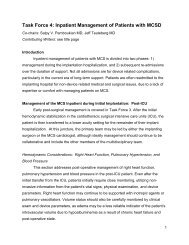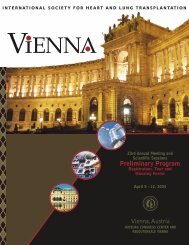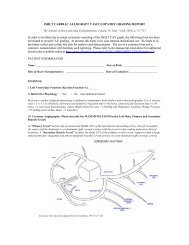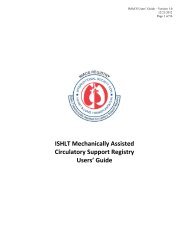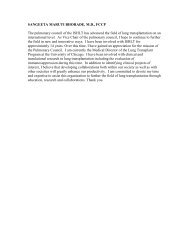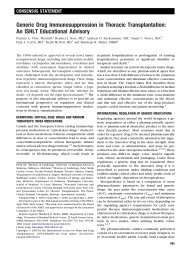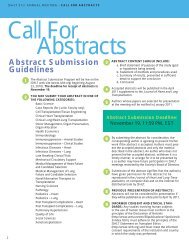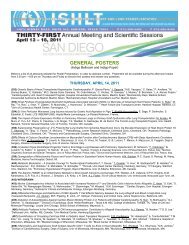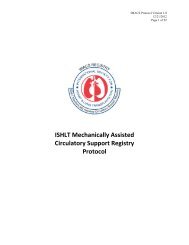Guidelines for the care of heart transplant recipients
Guidelines for the care of heart transplant recipients
Guidelines for the care of heart transplant recipients
Create successful ePaper yourself
Turn your PDF publications into a flip-book with our unique Google optimized e-Paper software.
Costanzo et al.<br />
<strong>Guidelines</strong> <strong>for</strong> Heart Transplant Care<br />
929<br />
Table 9 (A)<br />
Significant Differences in Adverse Events From <strong>the</strong> Major Clinical Trials<br />
First author (year) Study No. Renal function Infections<br />
Cholesterol &<br />
triglycerides Hypertension<br />
Kobashigawa 163 (1998) MMF vs AZA 650 MMF more<br />
any<br />
opportunistic<br />
infection<br />
Reichart 209 (1998) TAC vs CYA 82 NS NS CYA more hypertension<br />
Taylor 153 (1999) TAC vs CYA 85 NS NS CYA <br />
higher<br />
CYA more hypertension<br />
Eisen 157 (2003) EVL vs AZA 634 EVL groups <br />
worse renal<br />
function<br />
Keogh 156 (2004) SRL vs AZA 136 SRL groups <br />
worse renal<br />
function<br />
EVL groups <br />
lower viral/<br />
CMV but more<br />
bacterial<br />
infections<br />
SRL groups <br />
lower CMV but<br />
more<br />
pneumonia<br />
chol & tri<br />
EVL groups<br />
higher<br />
chol & tri<br />
NS <strong>for</strong> chol;<br />
SRL<br />
groups <br />
higher<br />
trig<br />
Grimm 154 (2006) TAC vs CYA 314 NS NS CYA <br />
higher<br />
Kobashigawa 158 (2006)<br />
TAC/MMF vs TAC/SRL<br />
vs CYA/MMF<br />
343 TAC/MMF <br />
best renal<br />
function<br />
TAC/SRL <br />
lower viral but<br />
more fungal<br />
infections<br />
Baran 159 (2007) TAC/MMF vs TAC 58 NS TAC/MMF <br />
more<br />
hospitalized<br />
infections<br />
Lehmkuhl 160 (2008)<br />
See Table 8 <strong>for</strong> abbreviations.<br />
EVL/rd-CYA vs<br />
MMFsd-CYA<br />
176 NS EVL Less CMV<br />
infections<br />
chol & tri<br />
NS <strong>for</strong> chol;<br />
TAC/MMF<br />
lower<br />
trig<br />
NS<br />
NS<br />
CYA more hypertension<br />
NS<br />
... ...<br />
... ...<br />
Level <strong>of</strong> Evidence: C.<br />
2. In adults, <strong>the</strong> use <strong>of</strong> statins beginning 1 to 2 weeks after<br />
HT is recommended regardless <strong>of</strong> cholesterol levels.<br />
Owing to pharmacologic interactions with CNI and risk<br />
<strong>for</strong> toxicity, initial statin doses should be lower than<br />
those recommended <strong>for</strong> hyperlipidemia.<br />
Level <strong>of</strong> Evidence: A.<br />
3. Creatinine kinase levels should be monitored in all children<br />
receiving statins.<br />
Level <strong>of</strong> Evidence: C.<br />
Class IIa:<br />
1. Calcineurin inhibitor-based <strong>the</strong>rapy remains <strong>the</strong> standard<br />
in immunosuppressive protocols used after HT.<br />
Level <strong>of</strong> Evidence: B.<br />
2. MMF, EVL, or SRL as tolerated, should be included in<br />
contemporary immunosuppressive regimens because<br />
<strong>the</strong>rapies including <strong>the</strong>se drugs have been shown to reduce<br />
onset and progression <strong>of</strong> cardiac allograft vasculopathy<br />
(CAV) as assessed by intravascular ultrasound<br />
(IVUS).<br />
Level <strong>of</strong> Evidence: B.<br />
3. Immunosuppressive induction with polyclonal antibody<br />
preparations may be beneficial in patients at high risk <strong>of</strong><br />
renal dysfunction when used with <strong>the</strong> intent to delay or<br />
avoid <strong>the</strong> use <strong>of</strong> a CNI.<br />
Level <strong>of</strong> Evidence: B.<br />
4. In pediatric HT <strong>recipients</strong>, routine use <strong>of</strong> induction <strong>the</strong>rapy<br />
with a polyclonal preparation is indicated when<br />
complete CS avoidance is planned after HT.<br />
Level <strong>of</strong> Evidence: C.<br />
5. Routine use <strong>of</strong> statins is recommended <strong>for</strong> all pediatric<br />
patients with evidence <strong>of</strong> hyperlipidemia, CAV, or after<br />
re<strong>transplant</strong>ation.<br />
Level <strong>of</strong> Evidence: C.<br />
6. TAC is <strong>the</strong> preferred CNI <strong>for</strong> pediatric HT <strong>recipients</strong><br />
considered at high immunologic risk (eg, sensitized<br />
<strong>recipients</strong> with evidence <strong>of</strong> donor-specific antibody<br />
[DSA]).<br />
Level <strong>of</strong> Evidence: C.<br />
7. CS avoidance, early CS weaning, or very low dose maintenance<br />
CS <strong>the</strong>rapy are all acceptable <strong>the</strong>rapeutic approaches.<br />
Level <strong>of</strong> Evidence: B.



